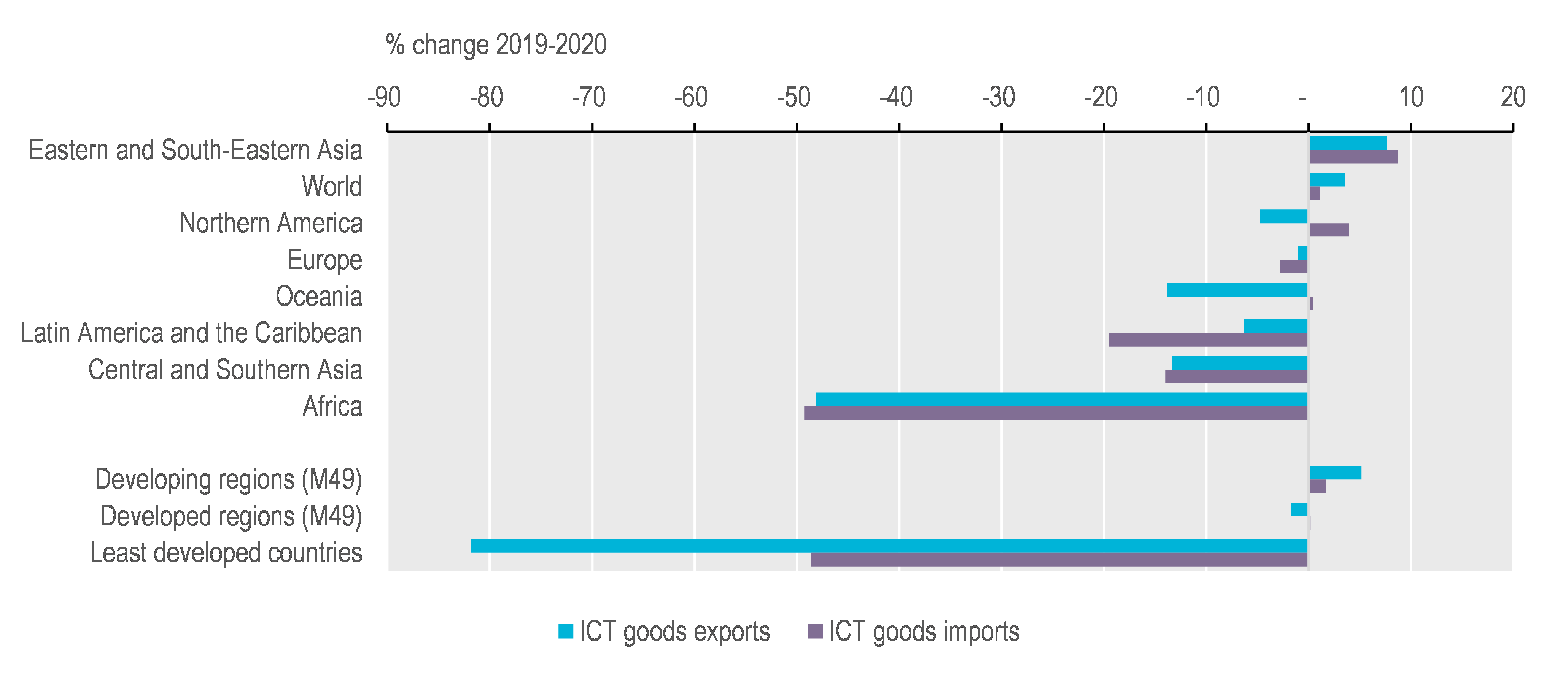The latest data for 2020 show growing reliance on digital technologies, boosting international trade of computers and related equipment and reversing falls seen in 2019.

Photo courtesy of government of Botswana
By accelerating digitalization, COVID-19 appears to have boosted trade in information and communication technology (ICT) goods, which had declined before the pandemic, according to an UNCTAD technical note on the pandemic’s impact on trade in the digital economy, published on 21 October.
Against a backdrop of sharply declining merchandise trade, the share of ICT goods in merchandise imports surged from around 13% in 2019 to nearly 16% in 2020 – the greatest annual increase since records began in 2000.
“The pandemic has made affordable ICT goods imports even more important for countries at early stages of the digital transformation – the same countries that saw the biggest falls in ICT goods imports in 2020,” said Shamika N. Sirimanne, UNCTAD director of technology and logistics.
“In this context, adopting trade facilitation and customs automation measures to smooth import processes will be important to improve access to the equipment needed in the digital economy.”
ICT goods’ exports exceed $2.3 trillion
Global exports of ICT goods increased by 4%, to over $2.3 trillion in 2020. Meanwhile, imports of such goods grew by 1.1%, rising $27 billion to almost $2.5 trillion.
This reflects an accelerating reliance on digital technologies during the lockdown measures introduced in many economies and stands out against overall falls in economic activities in the wake of the pandemic – in which overall merchandise trade contracted by around 7.5%, according to both export and import data.
In 2020, computers and peripheral equipment overtook communication equipment as the second largest component of ICT imports – after electronic components – for the first time since 2013. Indeed, in 2020, imports of computers and peripheral equipment increased by 3% while imports of communication and consumer electronic equipment fell by around 10%.
The COVID-19 pandemic is likely to have helped to drive this by incentivizing purchases of desktop computers and laptops more suited to in-depth work than communications devices such as smartphones, as well as peripherals such as screens, speakers, keyboards and mice that can aid in working from home.
At the same time, reduced incomes and financial uncertainty resulting from the pandemic may have suppressed demand for upgrades to mobile devices and consumer electronics.
Benefits to countries vary
Countries have differed in the extent to which they have been able to benefit from demand for ICT products (Figure). The upward trend in ICT goods exports was driven by eastern and southeastern Asia, where they surged by 8%. In all other regions exports declined but by far the sharpest drops occurred in least developed countries (LDCs) (-82%) and Africa (-48%).
The picture on imports is more mixed. While most regions registered declines in ICT goods imports in 2020, North America and Asia (as a whole) each saw an increase of 4%, with the latter powered by demand in eastern and southeastern Asia. Oceania also registered some growth (0.4%).
While import demand in developed regions stayed relatively flat (a 0.2% change), across developing regions ICT goods imports increased by 2% overall. However, this conceals considerable differences between developing countries as imports of ICT goods to LDCs and Africa declined by half.
Figure. Change in ICT goods exports and imports, 2019-2020

Note: Not adjusted for re-exports/re-imports due to data availability. Changes calculated in current prices (i.e. not adjusted for price changes between periods).
Source: UNCTAD based on UNCTAD digital economy statistics (unctadstat.unctad.org)
The pandemic appears to be exacerbating existing divides by pushing countries with low levels of digitalization further behind. This hampers their ability to engage in digital trade when it has become even more important.
It is now more urgent than ever to help those trailing in digital readiness to catch up. UNCTAD offers a range of technical assistance and capacity-building to support countries in engaging with and measuring their performance related to e‑commerce and the digital economy.


